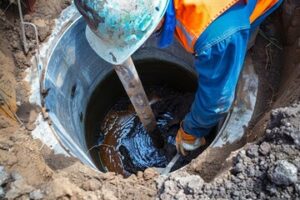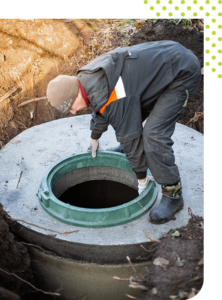Every time you flush a toilet, shower or wash clothes, wastewater flows through your sewer line to the septic tank. Solid materials settle in the tank’s bottom, while grease and lightweight masses float to the top as sludge.

Getting your septic tank pumped regularly prevents the build-up of these solids. It also ensures that new wastewater has enough space to flow through your drain field. Contact The Septic Guys for professional help.
Septic systems are a critical component of a healthy home and must be regularly inspected and serviced to ensure they continue to function properly. Without proper maintenance, septic tanks can overflow and drainfields may fail. This can lead to foul odors, blockages in plumbing, and the potential for disease-causing organisms to enter the house. Fortunately, regular septic system cleaning and pumping can prevent these issues.
The frequency of septic tank pumping depends on household size and usage, as well as the septic system design. Larger tanks require more frequent pumping than smaller ones. Similarly, heavy household use increases the amount of wastewater that flows through the septic system. A properly functioning septic system will not only reduce repair costs, but it will also help preserve water resources.
Regular septic system service can prevent expensive emergency repairs, such as drainfield failure. This is why it’s important to budget for septic services, including routine septic tank cleaning and inspections.
Homeowners can take a few simple steps to keep septic system service costs low, including keeping septic tank lids clear and uncovering them for the technician’s arrival. They should also avoid putting any non-biodegradable materials down the drains, such as paper towels, cigarette butts, coffee grounds, chemical drain cleaners, and bleach. Using a garbage disposal is also not recommended, since it can overwork the septic system and clog the drains.
In addition, homeowners should be sure to keep the septic system drainfield away from trees and structures, which can cause costly damage. If a homeowner suspects septic system problems, it’s best to contact a professional septic service company right away.
Having a field service management software solution like Smart Service can streamline dispatching and scheduling for septic tank and cesspool cleaning and other recurring maintenance. This can save you time and money while improving customer retention and boosting profitability. Request a free demo to see how it can work for your septic business. Whether you manage a small or large-scale septic service, it’s essential to have the right tools to keep your customers happy. Smart Service can help you save time and money by streamlining your customer database, scheduling, and recurring maintenance agreements.
Convenient
Septic systems are an important part of modern sanitation for homes and businesses that are not connected to municipal sewer lines. They provide a safe and reliable alternative to traditional plumbing and can be used for many years with proper maintenance. However, like any system, septic systems can occasionally experience problems that require professional attention. Emergency septic services, such as those offered by Septic 911, provide quick and effective solutions to help keep your home or business functioning properly.
During a septic inspection, the technician looks for signs of problems and makes repairs as needed. They will also check the drain field to ensure it is absorbing wastewater properly. In addition, they may use specialized equipment to inspect hard-to-reach components of your septic system. Once the inspection is complete, they will send you a report that includes their findings and recommendations. Following these tips can help prevent costly repairs in the future.
Unpleasant odors are a sure sign that your septic system isn’t functioning properly. These unpleasant odors could be caused by a full tank, a breach in the system, or clogs that block gases from escaping through vents. If you’re experiencing this problem, it’s best to contact a professional right away to avoid sewage backups or other more serious problems.
While septic systems are usually more reliable than sewer systems, it’s still a good idea to schedule regular septic system inspections and pumping. This is especially true if you have children or pets, as their waste can enter the septic system and cause problems. Having your septic system inspected and pumped regularly will reduce the risk of damage, and it will also help you save money on utility bills.
It’s also a good idea to talk to several companies before having your septic tank pumped. Obtaining quotes from multiple service providers can help you determine the most competitive price for your needs. You should also make sure the company you choose can locate your septic tank and inspection ports, which may be covered by overgrown vegetation or soil. Having these components easily accessible will enable the technician to quickly and efficiently perform the work.
Environmentally friendly
Septic systems help to protect public health and safeguard the environment by preventing the pollution of water resources. Properly functioning septic systems prevent sewage waste from being discharged into rivers, lakes and groundwater, preserving the quality of drinking water. When septic systems fail, however, they can pollute the surrounding water sources, posing a significant threat to environmental and human health. This is why regular maintenance services are crucial to ensuring that septic systems continue to function effectively for the long term.
When choosing a septic tank service provider, be sure to find one that follows environmentally friendly practices for cleaning and disposing of the septic waste. This will ensure that the waste is not contaminated with chemicals that could damage soil and water sources. Also, choose a company that uses non-toxic, biodegradable cleaners that are safe for the environment.
During installation, a licensed site evaluator will inspect the property and determine the best type of septic system for the home. Once the design is approved, a certified professional will install the system. Afterward, the system will be inspected by a qualified inspector to ensure that it is working correctly. Regular inspections will help to catch any problems before they become serious.
A septic system is a buried, water-tight container that holds wastewater until it becomes sufficiently degraded to be released into the soil. Solids settle to the bottom of the tank as sludge, and oil and grease float to the top as scum. The liquid wastewater (effluent) exits the tank through a piping network that runs underground into the drain field. The soil accepts and treats the effluent before it is dispersed into groundwater or surface water.
To reduce the amount of septic system waste, use water-conserving appliances and fixtures, and repair any leaky faucets or toilets. Limit the use of garbage disposals and avoid putting paint thinner, polyurethane, pesticides, some dyes, disinfectants, water softeners, and bleach into the septic system. Instead, use standard household cleaners and drain cleansers sparingly and according to product label instructions.
Regular septic system cleaning and pumping will reduce the risk of backups, improve indoor air quality, and increase home value. Moreover, septic system maintenance will prevent bad odors from developing around the house and in the yard, making it easier to maintain a beautiful, healthy garden.
Increases home value
Septic systems are an integral part of many homes in rural areas, as well as some cities. These systems are usually more efficient than connecting to city sewer lines, and they offer a cost-effective alternative. However, there are some disadvantages to living on a septic system, such as the need for regular maintenance. If your septic system is not properly maintained, it could cost you more in the long run. This is why it’s important to get a septic inspection before selling your home.
A well-functioning septic tank system can significantly increase property value, especially if it’s recently replaced or in good condition. The system’s eco-friendly nature is another perk that may attract buyers. Moreover, it will help your property to stand out in the Sydney real estate market.
While some potential buyers might be apprehensive about buying a home with a septic system, you can boost your chances of selling by getting the system inspected and making the necessary repairs before listing it. This will give you peace of mind and confidence in the system’s condition, which can help you sell your house faster.
When listing your home, make sure you provide prospective buyers with documentation related to the septic system, including records of inspections and pumping schedules. This will show that the septic system has been well-maintained and is in good working order. It will also show that you’re dedicated to the health and safety of your family, which can be an attractive feature for buyers.
The septic system is a large investment, and it’s important to keep it in tip-top shape. Septic systems require a lot of maintenance, and it’s best to hire a professional who can handle all of the necessary work. It’s worth the investment in the long run, and it will help you sell your home for a higher price.
In addition to boosting the saleability of your home, septic tank cleaning services can also reduce your energy bills. By reducing the amount of waste in your septic tank, you can save up to $200 per year on your utilities.
